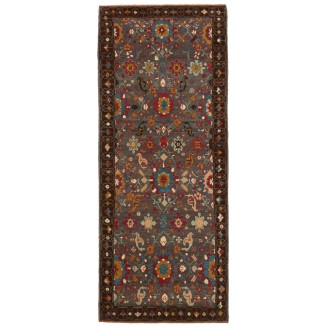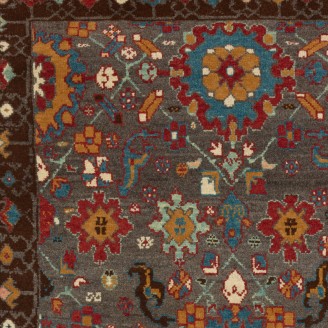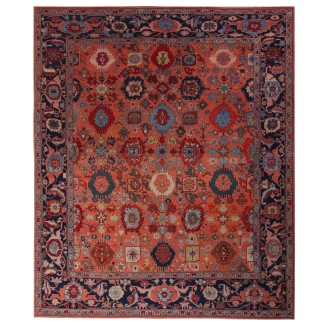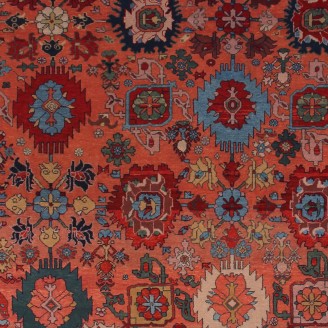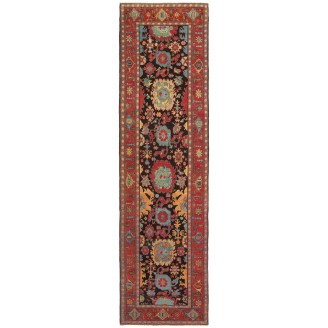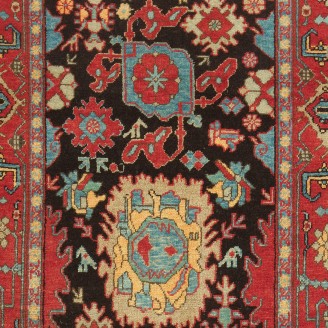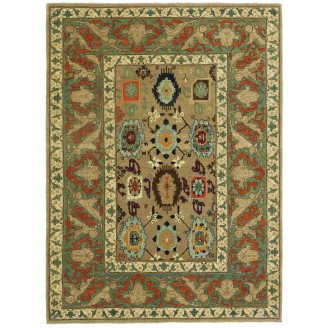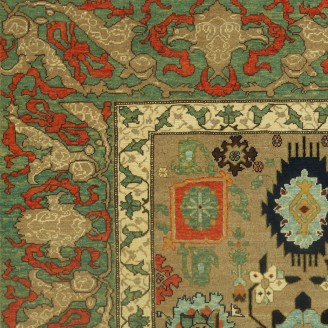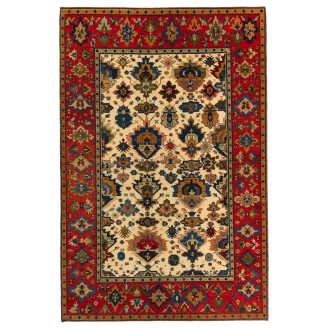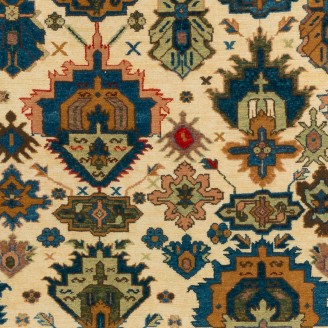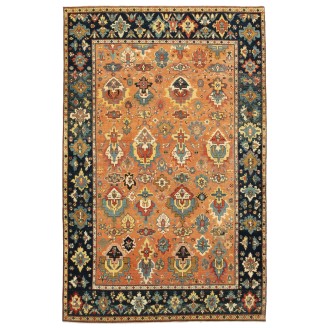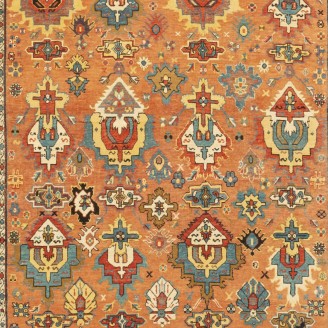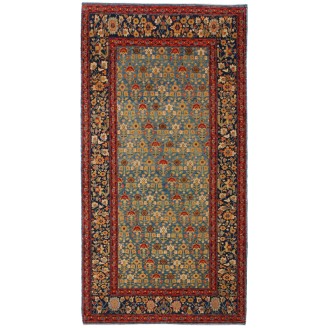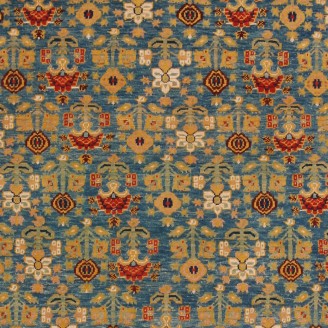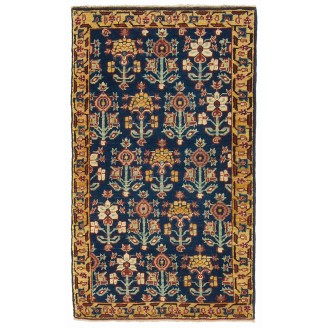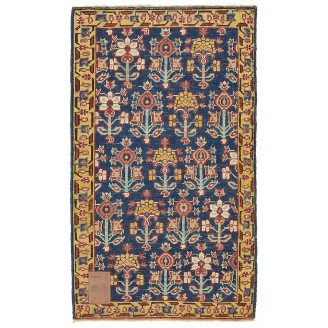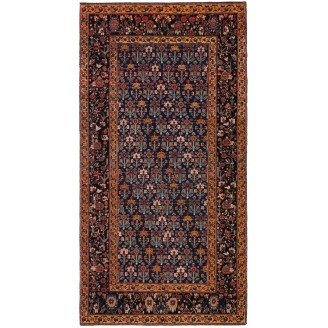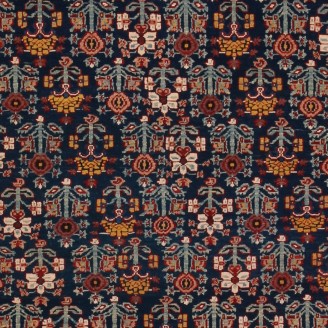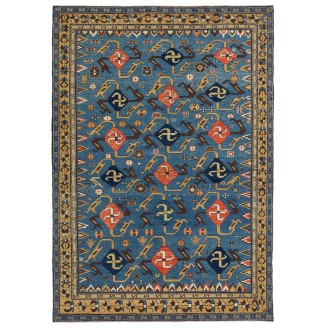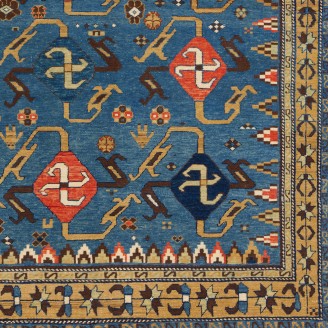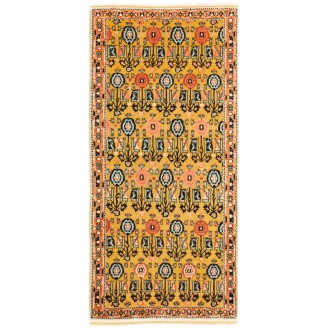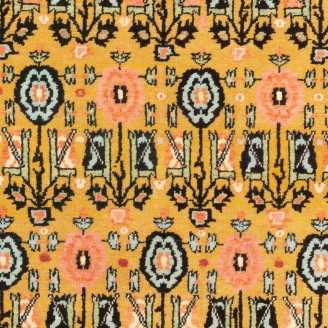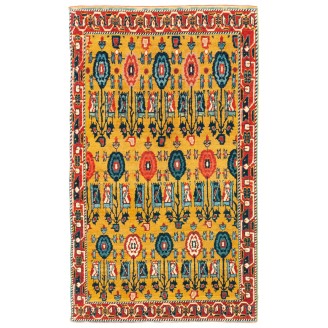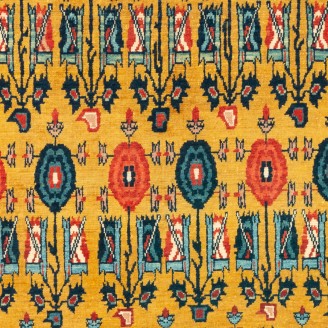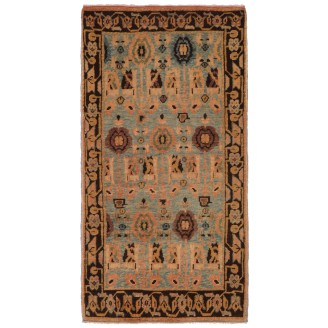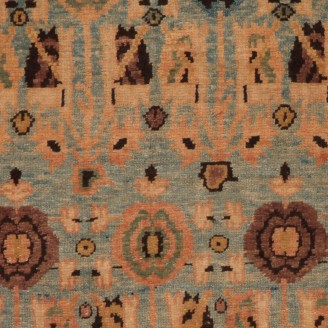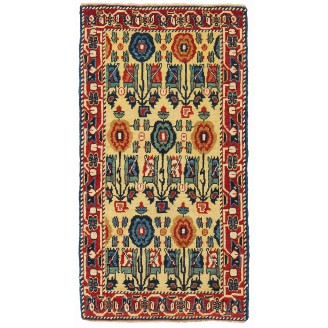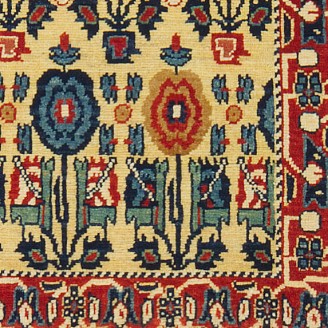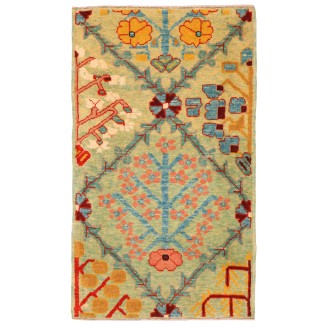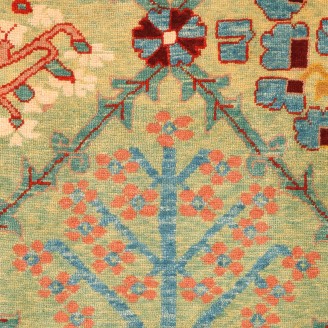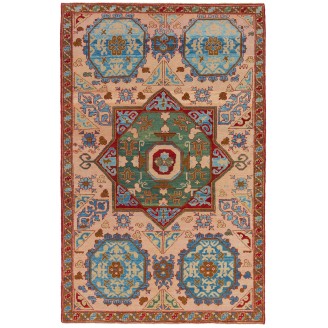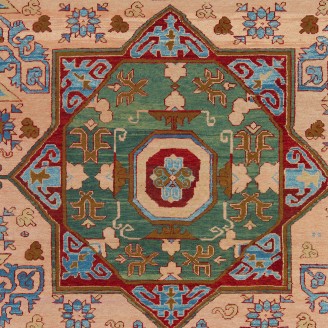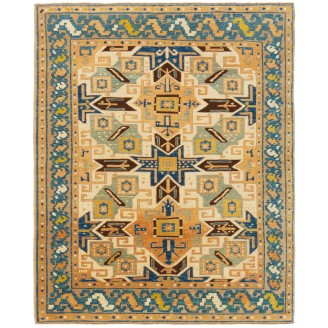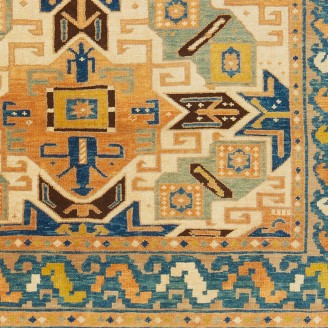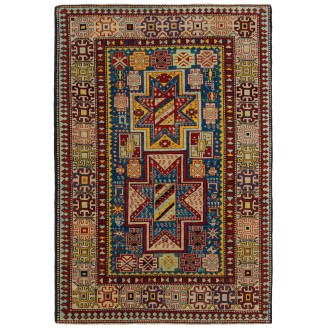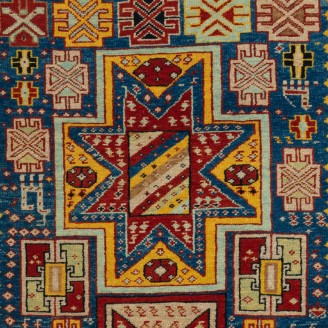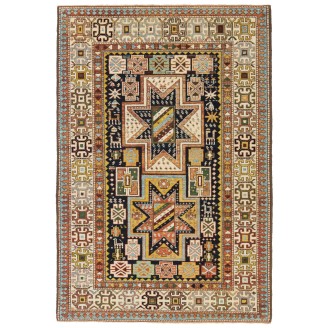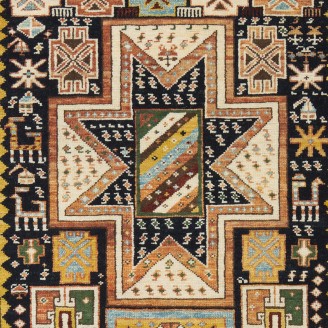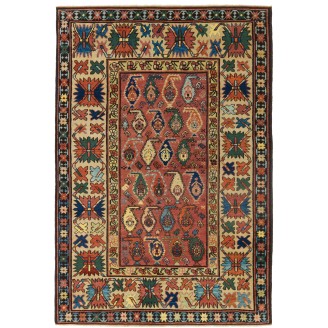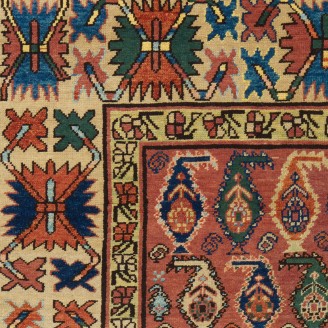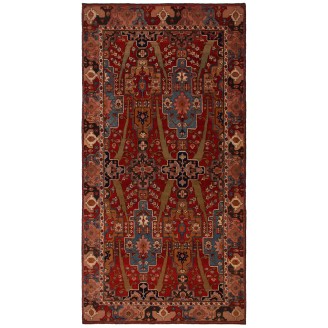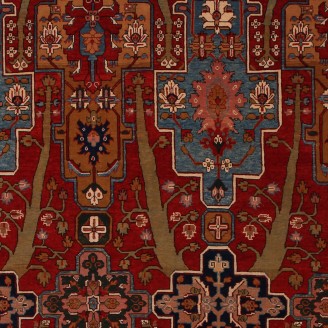Model: ART00544
Dimensions: 2'9" X 6'10"(86cm x 210cm)
This offset pattern is composed of palmettes and flowers, one has the impression that it is only part of a larger scheme designed 19th-century rug from the Bidjar region, Eastern Kurdistan area. Very similar palmettes, drawn in a curvilinear manner and combined with identical forked leaves, can be s..
Price:
$2,850
Ex Tax:$2,850
Model: ART00043
Dimensions: 8'2" X 9'11"(249cm x 304cm)
This offset pattern is composed of palmettes and flowers, one has the impression that it is only part of a larger scheme designed 19th-century rug from Bidjar region, Eastern Kurdistan area. Very similar palmettes, drawn in a curvilinear manner and combined with identical forked leaves, can be seen ..
Price:
$22,000
Ex Tax:$22,000
Model: ART00402
Dimensions: 2'7" X 9'8"(81cm x 296cm)
This offset pattern is composed of palmettes and flowers, one has the impression that it is only part of a larger scheme designed 19th-century rug from the Bidjar region, Eastern Kurdistan area. Very similar palmettes, drawn in a curvilinear manner and combined with identical forked leaves, can be s..
Price:
$3,700
Ex Tax:$3,700
Model: ART00512
Dimensions: 5'0" X 6'9"(154cm x 206cm)
This offset pattern is composed of palmettes and flowers, one has the impression that it is only part of a larger scheme designed for 19th-century rugs from the Bidjar region, Eastern Kurdistan area. Very similar palmettes, drawn in a curvilinear manner and combined with identical forked leaves, can..
Price:
$5,970
Ex Tax:$5,970
Model: ART00477
Dimensions: 4'11" X 7'6"(152cm x 230cm)
The source of the rug comes from the book Orient Star - A Carpet Collection, E. Heinrich Kirchheim, Hali Publications Ltd, 1993 nr.75. This offset pattern is composed of ascending shield-like palmettes flanked by leaf-like wings designed for 17th to 18th-century rugs from Azerbaijan, the North-west ..
Price:
$6,500
Ex Tax:$6,500
Model: ART00297
Dimensions: 5'10" X 9'0"(180cm x 275cm)
The source of the rug comes from the book Orient Star - A Carpet Collection, E. Heinrich Kirchheim, Hali Publications Ltd, 1993 nr.75. This offset pattern is composed of ascending shield-like palmettes flanked by leaf-like wings designed for 17th to 18th-century rugs from Azerbaijan, the North-west ..
Price:
$9,200
Ex Tax:$9,200
Model: ART00376
Dimensions: 4'5" X 8'6"(135cm x 260cm)
The source of the rug comes from the book Antique Rugs of Kurdistan A Historical Legacy of Woven Art, James D. Burns, 2002 nr.36 This was an exclusive example of offset rows of ascending flowers design rug c.1800s from Garrus, Eastern Kurdistan area. This type of rug has been called "Joshagan" in th..
Price:
$6,500
Ex Tax:$6,500
Model: ART00326
Dimensions: 2'9" X 1'8"(85cm x 51cm)
The source of the rug comes from the book Antique Rugs of Kurdistan A Historical Legacy of Woven Art, James D. Burns, 2002 nr.36 This was an exclusive example of offset rows of ascending flowers design rug c.1800s from Garrus, Eastern Kurdistan area. This type of rug has been called "Joshagan" in th..
Price:
$825
Ex Tax:$825
Model: ART00233
Dimensions: 4'3" X 8'3"(131cm x 253cm)
The source of the rug comes from the book Antique Rugs of Kurdistan A Historical Legacy of Woven Art, James D. Burns, 2002 nr.36 This was an exclusive example of offset rows of ascending flowers design rug c.1800s from Garrus, Eastern Kurdistan area. This type of rug has been called "Joshagan" in th..
Price:
$6,100
Ex Tax:$6,100
Model: ART00469
Dimensions: 5'7" X 8'0"(171cm x 246cm)
The source of the rug comes from the book Orient Star - A Carpet Collection, E. Heinrich Kirchheim, Hali Publications Ltd, 1993 nr.17. This is a remarkable and very unusual swastika designed early 19th-century rug from the Central Caucasia area. This unusual pattern is not known on other rugs but is..
Price:
$7,500
Ex Tax:$7,500
Model: ART00328
Dimensions: 2'7" X 5'6"(80cm x 170cm)
The source of the rug comes from the book Antique Rugs of Kurdistan A Historical Legacy of Woven Art, James D. Burns, 2002 nr.28. This was an exclusive example of offset rows of flowers designed 18th-century rug from Senna, Eastern Kurdistan area. This example is special because the flowers are well..
Price:
$2,500
Ex Tax:$2,500
Model: ART00275
Dimensions: 2'8" X 4'5"(82cm x 137cm)
The source of the rug comes from the book Antique Rugs of Kurdistan A Historical Legacy of Woven Art, James D. Burns, 2002 nr.28. This was an exclusive example of offset rows of flowers designed 18th-century rug from Senna, Eastern Kurdistan area. This example is special because the flowers are well..
Price:
$1,950
Ex Tax:$1,950
Model: ART00241
Dimensions: 1'8" X 3'1"(51cm x 95cm)
The source of the rug comes from the book Antique Rugs of Kurdistan A Historical Legacy of Woven Art, James D. Burns, 2002 nr.28. This was an exclusive example of offset rows of flowers designed 18th-century rug from Senna, Eastern Kurdistan area. This example is special because the flowers are well..
Price:
$825
Ex Tax:$825
Model: ART00210
Dimensions: 1'8" X 3'2"(53cm x 98cm)
The source of the rug comes from the book Antique Rugs of Kurdistan A Historical Legacy of Woven Art, James D. Burns, 2002 nr.28. This was an exclusive example of offset rows of flowers designed 18th-century rug from Senna, Eastern Kurdistan area. This example is special because the flowers are well..
Price:
$825
Ex Tax:$825
Model: ART00204
Dimensions: 1'10" X 3'0"(56cm x 92cm)
The source of the rug comes from the book Antique Rugs of Kurdistan A Historical Legacy of Woven Art, James D. Burns, 2002 nr.6. This is one of the most popular and ubiquitous lattice designs of 18th-century rugs from Koliya'i, Southern Kurdistan area. Any danger of monotony is overcome both by the ..
Price:
$825
Ex Tax:$825
Model: ART00416
Dimensions: 5'6" X 8'5"(168cm x 258cm)
The source of carpet comes from the book Orient Star - A Carpet Collection, E. Heinrich Kirchheim, Hali Publications Ltd, 1993 nr.161. This exceptionally elegant and unusual central octagon figure is enclosed by an eight-pointed star-design 16th-century carpet from the West Turkey area. This carpet ..
Price:
$4,200
Ex Tax:$4,200
Model: ART00431
Dimensions: 4'3" X 5'2"(130cm x 158cm)
The source of the rug comes from the book Orient Star - A Carpet Collection, E. Heinrich Kirchheim, Hali Publications Ltd, 1993 nr.2. This is the best-known example of a Star Kazaks rug from the Mid 19th century from the Central Caucasus area. Star Kazak rugs are considered to be the most desirable ..
Price:
$2,300
Ex Tax:$2,300
Model: ART00550
Dimensions: 4'1" X 6'0"(126cm x 183cm)
This is a large stellar medallion with stripes in a cruciform border design rug from the 19th century, Shirvan region, Caucasus area. In the field, two large star medallions are covered with geometric, floral, with guarding animal decorations. It is framed with a series of borders. Vivid colors are ..
Price:
$2,760
Ex Tax:$2,760
Model: ART00480
Dimensions: 4'1" X 5'11"(126cm x 181cm)
This is a large stellar medallion with stripes in a cruciform border design rug from the 19th century, Shirvan region, Caucasus area. In the field, two large star medallions are covered with geometric, floral, with guarding animal decorations. It is framed with a series of borders. Vivid colors are ..
Price:
$2,700
Ex Tax:$2,700
Model: ART00482
Dimensions: 4'1" X 6'1"(125cm x 186cm)
This is a boteh rows design rug from the late 19th century, Talish Kazak region, Caucasus area. Rugs with diagonal rows of boteh can be found throughout the Caucasus and Persia. In the Caucasus itself, the best-known boteh rugs are from the Baku district in the central east coastal area, one particu..
Price:
$2,850
Ex Tax:$2,850
Model: ART00299
Dimensions: 6'6" X 12'9"(199cm x 389cm)
The source of carpet comes from the book Orient Star - A Carpet Collection, E. Heinrich Kirchheim, Hali Publications Ltd, 1993 nr.64 and Islamic Carpets, Joseph V. McMullan, Near Eastern Art Research Center Inc., New York 1965 nr.26. This is a long Khorassan Compartment and tree design 17th-century ..
Price:
$22,000
Ex Tax:$22,000
